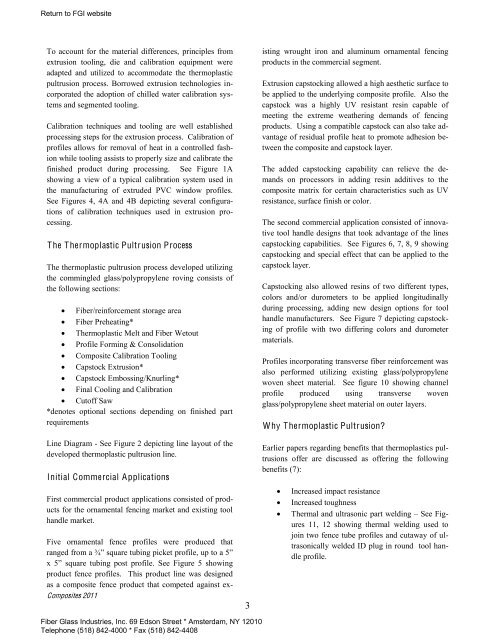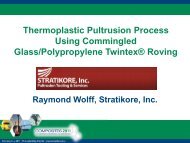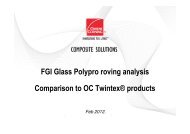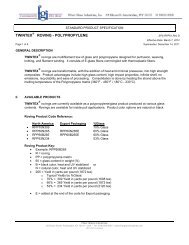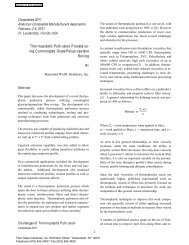Thermoplastic Pultrusion Process using commingled glass ...
Thermoplastic Pultrusion Process using commingled glass ...
Thermoplastic Pultrusion Process using commingled glass ...
You also want an ePaper? Increase the reach of your titles
YUMPU automatically turns print PDFs into web optimized ePapers that Google loves.
Return to FGI website<br />
To account for the material differences, principles from<br />
extrusion tooling, die and calibration equipment were<br />
adapted and utilized to accommodate the thermoplastic<br />
pultrusion process. Borrowed extrusion technologies incorporated<br />
the adoption of chilled water calibration systems<br />
and segmented tooling.<br />
Calibration techniques and tooling are well established<br />
processing steps for the extrusion process. Calibration of<br />
profiles allows for removal of heat in a controlled fashion<br />
while tooling assists to properly size and calibrate the<br />
finished product during processing. See Figure 1A<br />
showing a view of a typical calibration system used in<br />
the manufacturing of extruded PVC window profiles.<br />
See Figures 4, 4A and 4B depicting several configurations<br />
of calibration techniques used in extrusion processing.<br />
The <strong>Thermoplastic</strong> <strong>Pultrusion</strong> <strong>Process</strong><br />
The thermoplastic pultrusion process developed utilizing<br />
the <strong>commingled</strong> <strong>glass</strong>/polypropylene roving consists of<br />
the following sections:<br />
Fiber/reinforcement storage area<br />
Fiber Preheating*<br />
<strong>Thermoplastic</strong> Melt and Fiber Wetout<br />
Profile Forming & Consolidation<br />
Composite Calibration Tooling<br />
Capstock Extrusion*<br />
Capstock Embossing/Knurling*<br />
Final Cooling and Calibration<br />
Cutoff Saw<br />
*denotes optional sections depending on finished part<br />
requirements<br />
Line Diagram - See Figure 2 depicting line layout of the<br />
developed thermoplastic pultrusion line.<br />
Initial Commercial Applications<br />
Composites 2011<br />
3<br />
isting wrought iron and aluminum ornamental fencing<br />
products in the commercial segment.<br />
Extrusion capstocking allowed a high aesthetic surface to<br />
be applied to the underlying composite profile. Also the<br />
capstock was a highly UV resistant resin capable of<br />
meeting the extreme weathering demands of fencing<br />
products. Using a compatible capstock can also take advantage<br />
of residual profile heat to promote adhesion between<br />
the composite and capstock layer.<br />
The added capstocking capability can relieve the demands<br />
on processors in adding resin additives to the<br />
composite matrix for certain characteristics such as UV<br />
resistance, surface finish or color.<br />
The second commercial application consisted of innovative<br />
tool handle designs that took advantage of the lines<br />
capstocking capabilities. See Figures 6, 7, 8, 9 showing<br />
capstocking and special effect that can be applied to the<br />
capstock layer.<br />
Capstocking also allowed resins of two different types,<br />
colors and/or durometers to be applied longitudinally<br />
during processing, adding new design options for tool<br />
handle manufacturers. See Figure 7 depicting capstocking<br />
of profile with two differing colors and durometer<br />
materials.<br />
Profiles incorporating transverse fiber reinforcement was<br />
also performed utilizing existing <strong>glass</strong>/polypropylene<br />
woven sheet material. See figure 10 showing channel<br />
profile produced <strong>using</strong> transverse woven<br />
<strong>glass</strong>/polypropylene sheet material on outer layers.<br />
Why <strong>Thermoplastic</strong> <strong>Pultrusion</strong>?<br />
Earlier papers regarding benefits that thermoplastics pultrusions<br />
offer are discussed as offering the following<br />
benefits (7):<br />
Increased impact resistance<br />
First commercial product applications consisted of prod-<br />
Increased toughness<br />
ucts for the ornamental fencing market and existing tool<br />
Thermal and ultrasonic part welding See Fig-<br />
handle market.<br />
ures 11, 12 showing thermal welding used to<br />
join two fence tube profiles and cutaway of ul-<br />
Five ornamental fence profiles were produced that<br />
trasonically welded ID plug in round tool han-<br />
<br />
profile, up <br />
dle profile.<br />
x See Figure 5 showing <br />
product fence profiles. This product line was designed<br />
as a composite fence product that competed against ex-<br />
Fiber Glass Industries, Inc. 69 Edson Street * Amsterdam, NY 12010<br />
Telephone (518) 842-4000 * Fax (518) 842-4408


